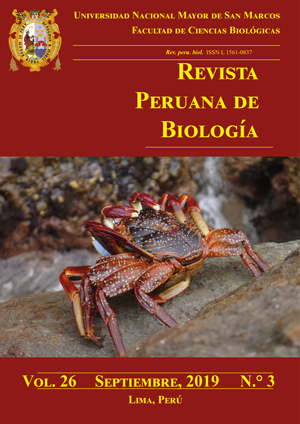Sixty-four new records for the flora of Peru from rapid biological inventories in the Peruvian Amazon
DOI:
https://doi.org/10.15381/rpb.v26i3.16780Keywords:
Amazonia, plants, first records, Field Museum, rapid inventories, PeruAbstract
Between 2000 and 2016 we carried out 15 rapid biological inventories in remote areas of the Andean foothills and Amazon basin in Peru. During these inventories, 27 botanists collected 9397 fertile vascular plant specimens. By the end of 2017, more than half of these specimens had been identified to species. Of the 2303 species identified to date, 64 species and 2 genera (Dicorynia and Monopteryx) are new records for the flora of Peru. If this rate of discovery proves typical, the number of new records for Peru in the rapid inventory material could increase, which indicates that there is still much to discover in the Peruvian flora.
Downloads
Downloads
Published
Issue
Section
License
Copyright (c) 2019 Luis A. Torres Montenegro, Marcos A. Ríos Paredes, Nigel C.A. Pitman, Corine F. Vriesendorp, Nancy Hensold, Ítalo Mesones Acuy, Nállarett Dávila Cardozo, Isaú Huamantupa, Hamilton W. Beltrán, Roosevelt García-Villacorta, Tony J. Mori Vargas, David A. Neill, Paul V.A. Fine, Jill T. López-López, Gabriela Núñez Iturri, Walter Palacios, Norma Salinas Revilla, William Trujillo Calderón

This work is licensed under a Creative Commons Attribution-NonCommercial-ShareAlike 4.0 International License.
AUTHORS RETAIN THEIR RIGHTS:
a. Authors retain their trade mark rights and patent, and also on any process or procedure described in the article.
b. Authors retain their right to share, copy, distribute, perform and publicly communicate their article (eg, to place their article in an institutional repository or publish it in a book), with an acknowledgment of its initial publication in the Revista Peruana de Biologia.
c. Authors retain theirs right to make a subsequent publication of their work, to use the article or any part thereof (eg a compilation of his papers, lecture notes, thesis, or a book), always indicating its initial publication in the Revista Peruana de Biologia (the originator of the work, journal, volume, number and date).






